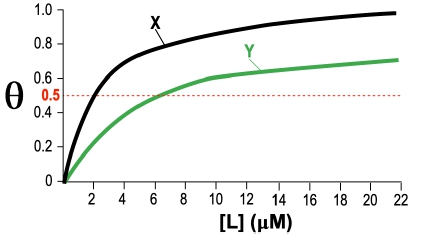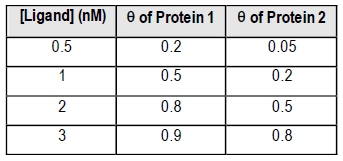In this video, we're going to begin our discussion on protein ligand fractional saturation. So first, we need to define fractional saturation, which can actually be abbreviated with 2 different variables. The first is the Greek letter theta, and the second is the capital letter Y. And so some textbooks use theta, other textbooks use Y, but on your exam or in some practice problems, you might find that either theta or Y could be used to represent the fractional saturation. So it's important for us to be able to recognize both of these variables. However, moving forward in our course, I'm mainly going to be using theta to represent the fractional saturation only because it's a little bit more unique and visually distinguishable. But I'll also be trying to remind you guys that every time you see theta in our lesson, we could easily replace the theta with capital Y. And so what exactly is this fractional saturation anyway? Well, it's just the fraction of occupied, or in other words, the fraction of saturated ligand binding sites in a protein sample. And so when a ligand binding site on a protein is occupied or saturated, it just means that that ligand binding site is bound to a ligand. And so this fractional saturation theta or Y is really just a ratio. And really it's just the ratio of occupied proteins over the total protein content. And so notice that's exactly what we're seeing down below in our image in our first box. So, we can see that the fractional saturation, theta or Y, is really just equal to this ratio of the occupied proteins, which are just the proteins that are bound by Ligand, over the total protein content. And so, notice that that's exactly what this ratio over here is expressing as well. So, the proteins that are bound by ligand is just going to be the concentration of protein Ligand complex. And then the total protein is just going to be the concentration of protein Ligand complex, plus the concentration of free protein.
Now, it's also important to recognize that this expression right here for the fractional saturation actually resembles the rectangular hyperbola equation, which recall that we covered way back when we talked about the Michaelis-Menten equation. And so we can see that in this rectangular hyperbola equation, the x's here represent the protein ligand concentration, and, the b represents the concentration of free protein, and then, of course, this A right here must be equal to a value of 1 in our equation up above because it's not being shown. And so notice that because it resembles a rectangular hyperbola that when we actually plot this data, we get a rectangular hyperbola like we see in this plot. Now, before we actually get down to this plot, it's important to note that this fractional saturation, theta or Y, can actually help us reveal the exact percentage of occupied ligand binding sites on a protein. And the values of the fractional saturation theta or Y are going to range from 0 at its minimum when there's absolutely no ligand that's bound to the protein. All the way up to the highest value of 1 when all of the protein binding sites are bound by ligand. And so, at this point, we already know. So, recall from our previous lesson videos that the dissociation equilibrium constant, capital Kd, has units of molarity and it's equal to the exact Ligand concentration that allows for 50% of all of the available Ligand binding sites to be occupied. And so, 50% corresponds with theta or the fractional saturation equaling to a value of 0.5. And so down below, this plot that we see over here on the right is actually referred to as a saturation curve or a protein ligand binding graph. And what it does is it plots the fractional saturation, theta or Y, on the Y axis. So, we can put theta here or Y. And so that's what's plotted on the Y axis and then on the X axis, notice that it plots the ligand concentration. And so, you can see that when the value of the fractional saturation theta or Y is equal to 0.5, this is a very unique and critical point on these saturation curves or protein ligand binding graphs. And that's because when theta is equal to 0.5, the ligand concentration that's associated with that reveals the Kd, which is a measure of the affinity that the protein has for the ligand. And so in our next video, we'll be able to continue to talk more about the fractional saturation and how it applies directly to protein ligand interactions. And so I'll see you guys in that video.




